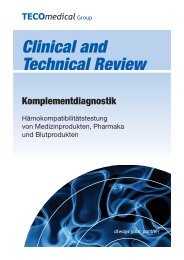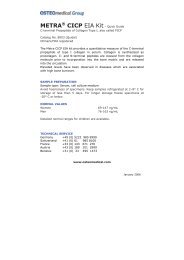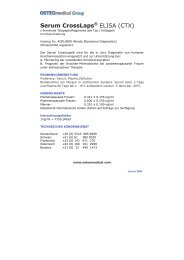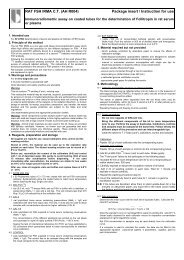Page 1 E N G LIS H D E U T S C H ITA LIA N O F R A N Ç A IS E S P ...
Page 1 E N G LIS H D E U T S C H ITA LIA N O F R A N Ç A IS E S P ...
Page 1 E N G LIS H D E U T S C H ITA LIA N O F R A N Ç A IS E S P ...
Create successful ePaper yourself
Turn your PDF publications into a flip-book with our unique Google optimized e-Paper software.
Representative Standard Curve<br />
Standard BAP levels: 0, 2, 20, 50, 80, 140 U/L<br />
LIM<strong>ITA</strong>TIONS OF THE PROCEDURE<br />
HAMA Interference<br />
Some individuals have antibodies to mouse antibodies (HAMA), which can cause interference in immunoassays that employ<br />
antibodies derived from mice. In particular, it has been reported that serum samples from patients who have undergone therapy or<br />
diagnostic procedures that include infusion of mouse monoclonal antibody may produce erroneous results. Therefore, Metra BAP<br />
results for such patients should be used only in conjunction with results from some other diagnostic procedure and with information<br />
available from the clinical evaluation of the patient.<br />
Samples with significant elevations of liver alkaline phosphatase activity may cause aberrantly elevated results in the Metra BAP assay.<br />
<strong>Page</strong>t’s patients who have low levels of disease may have bone-specific alkaline phosphatase levels that fall within the Metra BAP<br />
reference range.<br />
SAMPLE VALUES<br />
BAP reference ranges have been established for normal males over 25 years of age (n = 126), normal premenopausal females<br />
between the ages of 25 and 44 (n = 178), and normal postmenopausal females (n = 107). For the purposes of establishing<br />
reference ranges, normal subjects were defined as:<br />
� Basically healthy, no bone, endocrine or chronic disorders<br />
� Regular menstrual cycles (premenopausal females)<br />
� Not pregnant or breast feeding (females)<br />
� Not currently taking any medication known to influence bone metabolism<br />
Values may be influenced by such factors as low estrogen production, low calcium intake or low physical activity. 8 Estrogen<br />
deficiency in postmenopausal women can result in elevated bone turnover. 3,4 Each laboratory should establish its own normal<br />
reference range. The ranges are expressed as nonparametric reference intervals (90% CI).<br />
4<br />
Optical Density (405 nm)<br />
3.0<br />
2.0<br />
1.0<br />
Age (Yr) Range (U/L) Median<br />
Females 25 - 44 Premenopausal 11.6 - 29.6 18.3<br />
Females ≥ 45 Postmenopausal 14.2 - 42.7 25.0<br />
Males ≥ 25 15.0 - 41.3 23.2<br />
PERFORMANCE CHARACTER<strong>IS</strong>TICS<br />
Antibody Specifications<br />
The bone-specific alkaline phosphatase antibody has selective, high affinity for the bone-specific alkaline phosphatase isoform, low<br />
cross-reactivity to the liver form of alkaline phosphatase, and negligible binding of intestinal and placental isoenzymes.<br />
AP Isoenzyme % Reactivity<br />
Bone 100<br />
Liver 3 – 8<br />
Placental 0<br />
Intestine 0.4<br />
0.0<br />
0 25 50 75 100 125 150<br />
BAP (U/L)<br />
Sensitivity<br />
The minimum detection limit of the Metra BAP assay is 0.7 U/L, determined by the upper 3 SD limit in a zero standard precision study.<br />
Recovery - Spike Recovery<br />
Spike recovery was determined by adding a known quantity of purified BAP to serum samples with different levels of endogenous<br />
BAP. Typical results are provided after spiking serum samples with low, medium, and high concentrations of BAP and assaying in<br />
triplicate.









![PTH [Hormone Parathyroïdienne] Intacte ELISA](https://img.yumpu.com/1233682/1/190x245/pth-hormone-parathyroidienne-intacte-elisa.jpg?quality=85)






